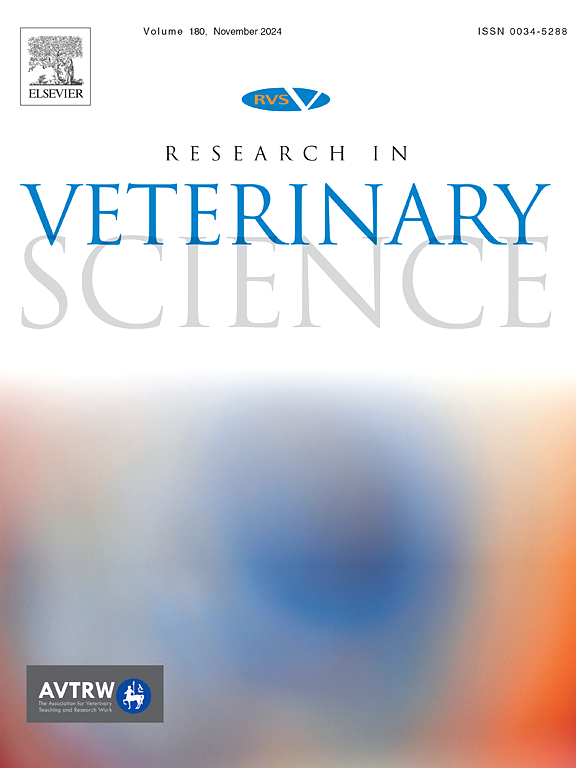天布苏病毒鸡源聚群3分离株对北京雏鸭和昆明小鼠的致病性
IF 2.2
3区 农林科学
Q1 VETERINARY SCIENCES
引用次数: 0
摘要
坦布苏病毒(TMUV)在遗传上可分为三组。迄今为止,与TMUV第3群在鸭子中的致病性有关的信息有限;TMUV簇3是否有可能在小鼠中诱导疾病尚不清楚。本研究通过比较鸡源性TMUV集群3毒株G (TMUV/G)与TMUV集群2.1毒株H (TMUV/H)在5日龄北京鸭和3周龄昆明小鼠模型中的致病性,对其致病性进行了评价。TMUV/G在雏鸭和小鼠中均引起神经系统疾病。而TMUV/G毒力比TMUV/H小,临床症状和显微病变更轻,发病率明显低于TMUV/H。TMUV/G对雏鸭的致死率为10%,对小鼠的致死率为60%,而TMUV/H对雏鸭的致死率为90%,对小鼠的致死率为60%。小鼠模型的进一步分析显示,TMUV/G在中枢神经系统中复制到较低水平,并在感染的大脑中诱导较低的IFN-β、IL-6、TNF-α和Viperin反应。与TMUV/H相比,TMUV/G在整个基因组中包含许多突变,并且在培养的海马神经元(HT22)细胞中的复制效率降低。综上所述,TMUV/G对北京雏鸭和昆明小鼠的毒力明显低于TMUV/H,表明簇3和2.1 TMUV之间存在不同的病毒-宿主相互作用。本研究有助于了解TMUV簇3的毒力表型,并将促进对TMUV簇3相对于TMUV簇2.1毒力大幅衰减机制的进一步研究。本文章由计算机程序翻译,如有差异,请以英文原文为准。
Pathogenicity of a chicken-origin cluster 3 isolate of Tembusu virus in Pekin ducklings and Kunming mice
Tembusu virus (TMUV) is genetically classified into three clusters. To date, information relating to the pathogenicity of TMUV cluster 3 in ducks is limited; whether TMUV cluster 3 has the potential to induce disease in mice remains unclear. Here, we evaluated the pathogenicity of a chicken-origin TMUV cluster 3 strain G (TMUV/G) in 5-day-old Pekin duck and 3-week-old Kunming mouse models by comparing with TMUV cluster 2.1 strain H (TMUV/H). TMUV/G caused neurological diseases in both ducklings and mice. Whereas TMUV/G was less virulent than TMUV/H, with more mild clinical signs and microscopic lesions and significantly lower morbidity. TMUV/G caused 10 % mortality in ducklings and failed to cause mortality in mice, in sharp contrast with 90 % mortality in ducklings and 60 % mortality in mice induced by TMUV/H. Further analysis with the mouse model revealed that TMUV/G replicated to lower levels in the central nervous system, and induced lower IFN-β, IL-6, TNF-α, and Viperin responses in the infected cerebrum. Compared with TMUV/H, TMUV/G contained a number of mutations throughout the genome and had a reduced replication efficiency in cultured hippocampal neuronal (HT22) cells. Together these findings suggest that TMUV/G displays markedly lower virulence in Pekin ducklings and Kunming mice relative to TMUV/H, indicating that different virus-host interactions exist between cluster 3 and 2.1 TMUVs. The present work contributes to the understanding of virulence phenotype of TMUV cluster 3, and will stimulate further studies on the mechanism for substantial virulence attenuation of TMUV cluster 3 relative to TMUV cluster 2.1.
求助全文
通过发布文献求助,成功后即可免费获取论文全文。
去求助
来源期刊

Research in veterinary science
农林科学-兽医学
CiteScore
4.40
自引率
4.20%
发文量
312
审稿时长
75 days
期刊介绍:
Research in Veterinary Science is an International multi-disciplinary journal publishing original articles, reviews and short communications of a high scientific and ethical standard in all aspects of veterinary and biomedical research.
The primary aim of the journal is to inform veterinary and biomedical scientists of significant advances in veterinary and related research through prompt publication and dissemination. Secondly, the journal aims to provide a general multi-disciplinary forum for discussion and debate of news and issues concerning veterinary science. Thirdly, to promote the dissemination of knowledge to a broader range of professions, globally.
High quality papers on all species of animals are considered, particularly those considered to be of high scientific importance and originality, and with interdisciplinary interest. The journal encourages papers providing results that have clear implications for understanding disease pathogenesis and for the development of control measures or treatments, as well as those dealing with a comparative biomedical approach, which represents a substantial improvement to animal and human health.
Studies without a robust scientific hypothesis or that are preliminary, or of weak originality, as well as negative results, are not appropriate for the journal. Furthermore, observational approaches, case studies or field reports lacking an advancement in general knowledge do not fall within the scope of the journal.
 求助内容:
求助内容: 应助结果提醒方式:
应助结果提醒方式:


